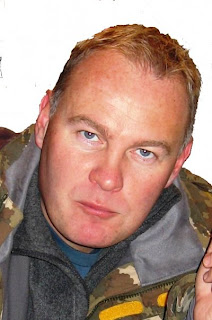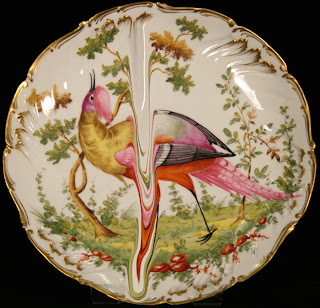>
Artist Jeffrey Sarmiento popped into the University of Sunderland’s Architectural Glass studio where our Fulbright workshop classes were being held with an invitation to show how he uses the National Glass Center’s waterjet to cut intricate and delicate glass elements for his artwork. Naturally, I was excited to see 1.) how the waterjet works and 2.) Jeffrey at work.
Jeffrey Sarmiento and Michael Janis
Jeffrey offered to make one of the component layers for the demo piece I was using to show how the sgraffito process can be achieved in glass, and he explained the process. We looked thru some of his images that were in the computer to save time, and selected one of his images of the nearby Tyne bridge that was part of his series “Invisible Cities“.
Jeffrey checks on the initialization of the process.
The pressurized water cuts through the glass and wood support panel.
The grit overflow tub.
The compressor unit located beyond the waterjet machinery.
The verticals of the waterjet cut Bullseye glass panel section are 3mm (less than 1/8″) thick.
Jeffrey pulls apart and assembles the positive and negative.
The connector nibs are pulled off each element.
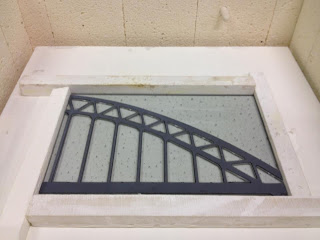
The panels section loaded and fused in the kiln.
The fired panel integrated into the demo piece.
Washington Glass Fulbright duo of Michael Janis & Tim Tate (plus Kay Janis as chaperone) soldiered on with dinner at the National Glass Centre, hosted by the University of Sunderland Board of Directors. The food at the dinner was a treat – my first Yorkshire Pudding. I was told that Yorkshire pudding and was told the story that the origins of the dish was to provide a cheap way to fill the diners – thus stretching a lesser amount of the more expensive ingredients as the Yorkshire pudding was traditionally served first. The dinner was nothing but elegant.
L-R Fulbright Scholar Tim Tate; Graeme Thompson, Dean of Faculty of Arts, Design and Media; Dr Kevin Petrie, Leader of Glass & Ceramics; (not shown in photo Shirley Atkinson, Deputy Vice-Chancellor; Peter Fidler CBE Vice Chancellor & Chief Executive and James Bustard, Director of the NGC).
The Yorkshire Pudding served.
L-R Cathy Barnes, Chair of the NGC Board; Kay Janis; Chris Jobe, Governor of the Board
Though not “lite” in the sense of calories, it was a delectable, light dessert that was served.
It was a lovely, fun evening that was filled with discussions on how we can create opportunities in both countries that would facilitate the exchange artists, ideas and ways we can strengthen the relationships we have developed.
We had time for one more workshop, held at Sunderland’s not-for-profit artist center, Creative Cohesion. This was to be a much more casual workshop, more a conversation – about the differences in the perceived US and the UK approach towards art and education, the changes that social media had on the art world, how artists can survive in tough economic times, the advantages of creating artist covenants.
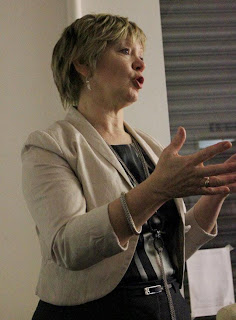
Anne Tye, the Creative Industries Development Manager at Sunderland City Council introduces Tim and Michael to a packed audience.


The talks were packed with artists from Sunderland, Newcastle – as far away as Edinburgh, Scotland.
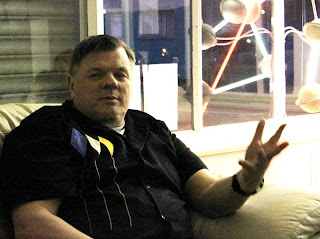
Tim Tate tells all.
The evening talk was the last of our scheduled Fulbright Scholar events. Our short project length had us fly out of town the next morning, heading back to Washington very early.
UK Artist profiles Part 3:
Andrew Livingston
Andrew Livingston works as an artist and is also Leader of CARCuos Ceramic Arts Research Center and MA Ceramics Program Leader at the University of Sunderland, The National Glass Center, Sunderland, UK.
Andrew’s work uses a range of media which acknowledges the interface between both traditional practice and new media. His continued exploration aims to challenge and expand contemporary locations in respect of the traditional positioning of ceramics. The integration of digital media and new technologies has become central to his artwork where new media is often positioned and juxtaposed with more traditional elements.
Andrew’s Parallax View series works in creating a fresh perspective on Tullie House‘s porcelain collection and explores preconceived notions of ceramics.
Surfeit 621 621 cast ceramic components, looped video, and drawings made from clay & graphite.
Britannia. ceramic and glass vitrine.
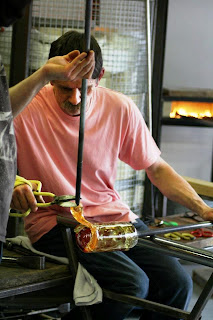
Roger Tye graduated from Manchester Poly in 1975 with a BA(Hons) in 3D Design – Glass and Metal. Roger to concentrate his work on sculptural and installation pieces that integrated glass and other media. Roger is the guiding force of the new not-for-profit artist studio – Creative Cohesion, located in Sunderland. Though Roger often works in creating beautiful traditional blown glass forms, he also works with slate and cast glass.

glass and slate
cast glass sheep, slate and steel
Click HERE to jump to first posting about the Sunderland trip.
